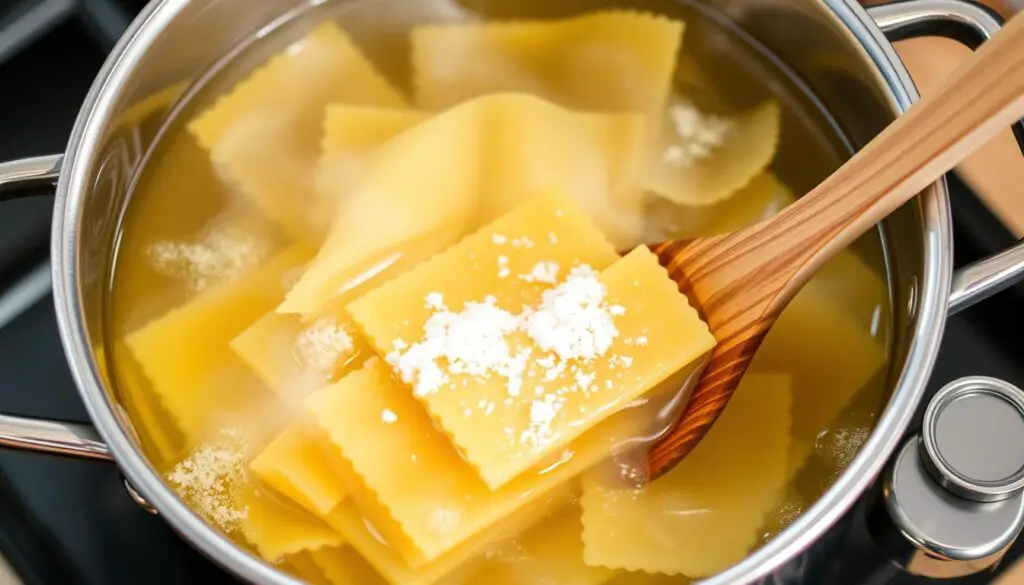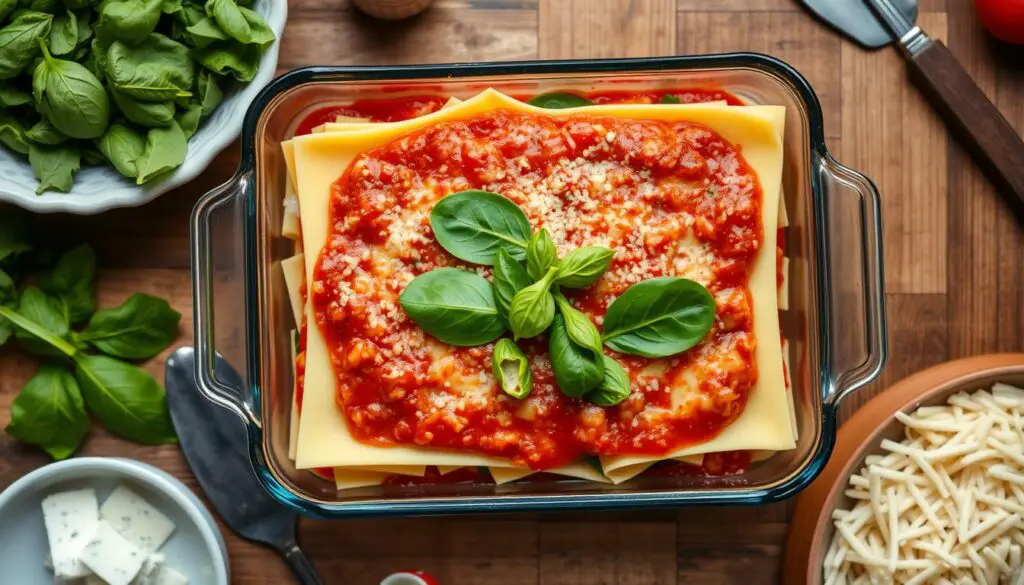Cooking lasagna noodles can be tricky because they tend to stick together. This makes the pasta clump, ruining the dish’s texture and look. To make a non-stick lasagna, it’s key to know how to prevent noodles from sticking.

This article will share strategies and tips for cooking lasagna noodles right. You’ll learn how to assemble them without any issues. By mastering how to prepare lasagna noodles, you can make a stunning lasagna that everyone will love.
Understanding the Problem of Sticky Lasagna Noodles
Sticky lasagna noodles can be a big problem in the kitchen. The common problems with lasagna often come from how we cook. If noodles stick together, it ruins the dish’s quality.
Not enough room in the pot is a big issue. Overcrowded noodles can’t move well, leading to clumps. Also, if the water isn’t boiling hard enough, noodles can become gummy.
Adding too many noodles at once makes things worse. Stirring well at the start helps water move around. This keeps noodles apart and prevents sticking. Knowing these tips can help you make perfect lasagna noodles.
Why Proper Water Temperature Matters
Getting the right water temperature for pasta is key for cooking lasagna noodles well. When the water boils vigorously, it prepares the noodles for perfect cooking. This prevents them from sticking together.
The Importance of Boiling Water
Using boiling water is vital to avoid sticky noodles. It quickly gelatinizes the starches, making cooking smoother. Make sure the water is boiling before adding noodles to prevent clumping.
This method ensures your lasagna has the right texture.
Avoiding Gummy Noodles
To avoid gummy noodles, wait until the water is boiling before adding pasta. Adding noodles too early can cause them to stick. Stir the noodles often in the beginning to prevent sticking.
Essential Tips for Cooking Lasagna Noodles
Cooking lasagna noodles right is key to a great dish. By following these tips, you can avoid sticky noodles and make a delicious meal.
Use Plenty of Water
Choosing the right amount of water is vital. Use a big pot with 4-6 quarts of water for each pound of noodles. This lets the noodles cook without sticking together.
Add Salt for Flavor and Texture
Salting the pasta water does two things. It makes the noodles taste better and helps prevent them from sticking. Use one tablespoon of salt for every 4 quarts of boiling water. This keeps the noodles tasty and their shape intact.
Stirring: The Key to Preventing Stickiness
Stirring pasta is very important. When noodles go into boiling water, they might stick together. Stir them well in the first few minutes to keep them separate and prevent stickiness.
How to Keep Lasagna Noodles From Sticking
Keeping lasagna noodles from sticking is key to a great dish. Cooking them right and deciding to rinse or not can make a big difference. By using a few important methods, you can keep the noodles perfect through baking.
Cook Al Dente for Best Results
Cooking lasagna noodles with the right texture is important. You want them to be firm but tender. This way, they’ll cook well in the oven and mix well with the sauce.
Rinsing: To Rinse or Not to Rinse?
Knowing when to rinse noodles is vital. Rinsing can stop clumping by removing starch. But, it might also reduce flavor mixing with the sauce. If you won’t use them right away, a quick rinse can help keep them apart.
Using Oil or Cooking Spray
Using oil on pasta is a common trick to avoid sticking. But, it can make the noodles less absorbent. Instead, lightly coat the cooked noodles with oil or cooking spray. This keeps them from sticking and helps the sauce stick better.

Managing Cooked Lasagna Noodles
Properly managing cooked lasagna noodles is key to their texture and taste. After boiling, draining and separating them well is important. This ensures a great lasagna experience without the problem of stickiness.
Proper Drainage After Cooking
Draining pasta right gets rid of excess water that can make it soggy. Use a colander to drain the noodles. Then, gently shake the colander to get rid of any remaining water.
This step is critical in keeping pasta non-sticky and keeping your dish perfect.
Separating Noodles Quickly
It’s important to separate cooked noodles quickly for a good lasagna. Waiting too long can cause them to clump. Lay the noodles flat on parchment paper or a lightly oiled surface.
This helps them stay separate and easy to handle. It makes how to manage cooked noodles a simple task.
Layering to Prevent Sticking
Layering is key to avoiding pasta stickiness with sauce. It keeps each noodle separate during baking. The right way to layer lasagna ensures a mix of flavors and textures without noodles sticking together.
Using Sauce and Cheese Generously
Using a lot of sauce and cheese between layers helps prevent sticking. For a 9×13-inch dish, use about 1 cup of sauce. This keeps the noodles from sticking together. Mixing ricotta cheese with eggs makes the filling fluffy, helping to keep the noodles apart.
Layering Techniques for Success
Good lasagna layering is vital. Start with a thin sauce layer at the bottom to prevent sticking. Then, alternate between noodles, sauce, and cheese. This method boosts flavor and ensures even heat during baking.
Make sure to have at least three full layers of sauce, cheese, and noodles. This will give you the best results.

Additional Methods for No-Stick Lasagna
Looking to make lasagna easy? No-boil noodles are a great choice. They make cooking simpler and taste delicious. Just remember, they soak up the sauce, so watch the liquid levels.
Using No-Boil Lasagna Noodles
No-boil noodles save time, perfect for quick meals. They’re great for those in a rush but want a tasty lasagna. Make sure to use more sauce to help them cook right.
Alternatives for Gluten-Free Options
Need gluten-free noodles? Try alternatives for pasta like rice or quinoa. They work like regular noodles but need careful watching. Adjust cooking times and moisture to avoid sticking.
Conclusion
Learning how to prevent sticky noodles is key to a great lasagna. Over 80% of home pasta makers face the problem of noodles sticking together. It’s important to use easy lasagna tips to avoid this.
Using semolina, corn, or rice flour helps prevent clumps and makes handling easier. Cooking lasagna sheets al dente for 8-10 minutes is important. Letting them rest for 10-15 minutes before serving is also a must.
Whether you make a classic lasagna, chicken Alfredo, or a gluten-free zucchini lasagna, knowing these tips is essential. By following these steps, you create a dish that’s not just tasty but also visually stunning.
This site participates in the Amazon Services LLC Associates Program, an affiliate advertising program designed to provide a means for us to earn fees by linking to Amazon.com and affiliated sites. As an Amazon Associate, I earn from qualifying purchases at no extra cost to you.


